
JBL Partybox 310 Portable Party Speaker
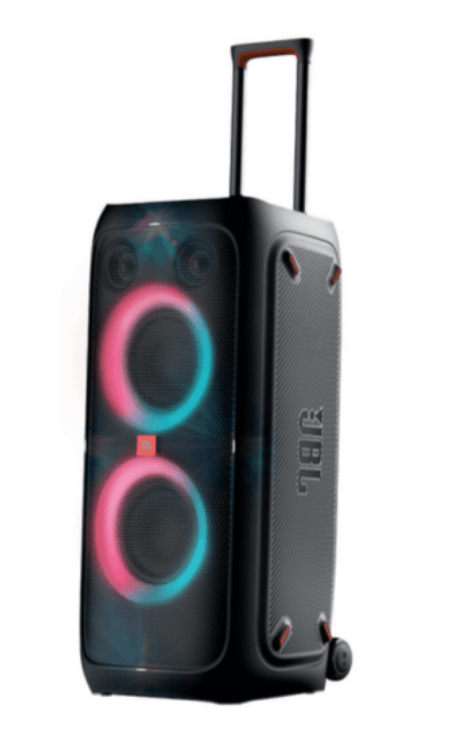
IMPORTANT SAFETY INSTRUCTIONS
For all products
- Read these instructions.
- Keep these instructions.
- Heed all warnings.
- Follow all instructions.
- Do not block any ventilation openings. Install this apparatus in accordance with the manufacturer’s instructions.
- Do not install this apparatus near any heat sources such as radiators, heat registers, stoves or other apparatus (including amplifiers) that produce heat.
- Do not defeat the safety purpose of the polarized or grounding-type plug. A polarized plug has two blades with one wider than the other. A grounding-type plug has two blades and a third grounding prong. The wide blade or the third prong is provided for your safety. If the provided plug does not fit into your outlet, consult an electrician for replacement of the obsolete outlet.
- Protect the power cord from being walked on or pinched, particularly at plugs, convenience receptacles and the point where they exit from the apparatus.
- Use only attachments/accessories specified by the manufacturer.
- Use only with the cart, stand, tripod, bracket or table specified by the manufacturer or sold with the apparatus. When a cart is used, use caution when moving the cart/apparatus combination
to avoid injury from tip-over. - Unplug this apparatus during lightning storms or when unused for long periods of time.
- To disconnect this apparatus from the AC mains completely, disconnect the power-supply cord plug from the AC receptacle.
- The mains plug of the power-supply cord shall remain readily operable.
- Do not expose batteries to excessive heat such as sunshine, fire or the like.
- This apparatus is intended to be used only with the power supply and/or charging cable provided by the manufacturer.
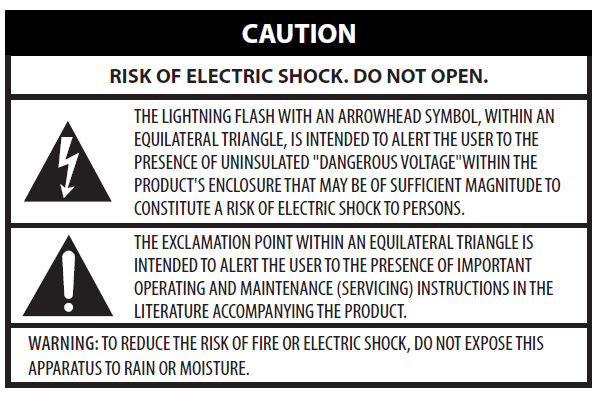
Caution FCC and IC statement for users (USA and Canada only)
This device complies with part 15 of the FCC Rules. Operation is subject to the following two conditions:
- This device may not cause harmful interference, and
- this device must accept any interference received, including interference that may cause undesired operation.
CAN ICES-3(B)/NMB-3(B)
Federal Communication Commission Interference Statement
This equipment has been tested and found to comply with the limits for a Class B digital device, pursuant to Part 15 of the FCC Rules. These limits are designed to provide reasonable protection against harmful interference in a residential installation. This equipment generates, uses and can radiate radio frequency energy and, if not installed and used in accordance with the instructions, may cause harmful interference to radio communications. However, there is no guarantee that interference will not occur in a particular installation. If this equipment does cause harmful interference to radio or television reception, which can be determined by turning the equipment off and on, the user is encouraged to try to correct the interference by one or more of the following measures:
- Reorient or relocate the receiving antenna.
- Increase the separation between the equipment and receiver.
- Connect the equipment into an outlet on a circuit different from that to which the receiver is connected.
- Consult the dealer or an experienced radio/TV technician for help.
Caution: Changes or modifications not expressly approved by HARMAN could void the user’s authority to operate the equipment.
For Products That Transmit RF Energy
FCC AND IC INFORMATION FOR USERS
This device complies with Part 15 of the FCC rules and Industry Canada license-exempt RSS standard(s). Operation is subject to the following two conditions:
- This device may not cause harmful interference; and
- this device must accept any interference received, including interference that may cause undesired operation.
FCC/IC Radiation Exposure Statement
This equipment complies with FCC/IC RSS-102 radiation exposure limits set forth for an uncontrolled environment.
FCC Caution:
High power radars are allocated as primary users of the 5.25 to 5.35 GHz and 5.65 to 5.85 GHz bands. These radar stations can cause interference with and/or damage this device. No configuration controls are provided for this wireless equipment allowing any change in the frequency of operations outside the FCC grant of authorization for US operation according to Part 15.407 of the FCC rules.
IC Caution
User should also be advised that:
- The device for operation in the band 5150-5250 MHz is only for indoor use to reduce the potential for harmful interference to o-channel mobile satellite systems;
- the maximum antenna gain permitted for devices in the bands 5250-5350 MHz and 5470-5725 MHz shall comply with the e.i.r.p. Limit: and
- The maximum antenna gain permitted for devices in the band 5725-5825 MHz shall comply with the e.i.r.p. Limits specified for point-to-point and non-point-to-point operation as appropriate.
- Users should also be advised that high-power radars are allocated as primary users (i.e. priority users) of the bands 5250-5350 MHz and 5650-5850 MHz and that these radars could cause interference and/or damage to LE-LAN devices.
Exposure of humans to RF fields (RSS-102)
The computers employ low gain integral antennas that do not emit RF field in excess of Health Canada limits for the general population; consult Safety Code 6, obtainable from Health Canada’s Website at http://www.hc-sc.gc.ca/ The radiated energy from the antennas connected to the wireless adapters conforms to the IC limit of the RF exposure requirement regarding IC RSS-102, Issue 5 clause 4. SAR tests are conducted using recommended operating positions accepted by the FCC/RSS with the device transmitting at its highest away from the body. Non-compliance with the above restrictions may result in a violation of FCC RF exposure guidelines.
Use Restriction: Attention in France, the operation is limited to indoor use within the band 5150-5350 Mhz.
For Products with Radio Receivers That Can Use an External Antenna (USA ONLY)
CATV (Cable TV) or Antenna Grounding
If an outside antenna or cable system is connected to this product, be certain that it is grounded so as to provide some protection against voltage surges and static charges. Section 810 of the National Electrical Code (NEC), ANSI/NFPA No. 700-1984, provides information with respect to proper grounding of the mast and supporting structure, grounding of the lead-in wire to an antenna discharge unit, of grounding conductors, location of antenna discharge unit, connection to grounding electrodes and requirements of the electrode.
Note to CATV System Installer
This reminder is provided to call the CATV(cable TV) system installer’s attention to article 820-40 of the NEC, which provides guidelines for proper grounding and, in particular, as close to the point of cable entry as possible.
Caution: This product uses a laser system. To prevent direct exposure to the laser, do not open the cabinet enclosure or defeat any of the safety mechanisms provided for your protection. Do NOT START INTO THE LASER BEAM. To ensure proper use of this product, please read the owner’s manual carefully and retain it for future use. Should the unit require maintenance or repair, please contact your local JBL service. Refer servicing to qualified personnel only.
FOR ALL EU COUNTRIES
For products that include audio out Prevention of hearing loss.
Caution: Permanent hearing loss may occur if earphones or headphones are used at high volume for prolonged periods of time. For France, the products have been tested to comply with Sound Pressure Level requirement laid down in the applicable NF EN 50332 L.5232-1.
Note:
- –To prevent possible hearing damage, do not listen to high volume levels for long periods.
WEEE Notice
The Directive on Waste Electrical Equipment (WEEE), which entered into force as European law on 14/02/2014, resulted in a major change in the treatment of electrical equipment at end-of-life.
The purpose of this Directive is, a first priority, the prevention of WEEE, and in addition, to promote the reuse, recycling and other forms of recovery of such wastes as so as to reduce disposal. The WEEE logo on the product or on its box indicating collection for electrical and electronic equipment consists of the crossed-out wheeled bin, as shown below. This product must not be disposed of or dumped with your other household waste.
You are liable to dispose of all your electronic or electrical waste equipment by relocating over to the specified collection point for recycling of such hazardous waste. Isolated collection and proper recovery of your electronic and electrical waste equipment at the time of disposal will allow us to help conserving natural resources. Moreover, proper recycling, and collection points, please contact your local city center, household waste disposal service, shop from where you purchased the equipment, or manufacturer of the equipment.
RoHS Compliance
This product is in compliance with Directive 2011/65/EU of the European Parliament and of the Council of 8 June 2011 on the restriction of the use of certain hazardous substances in electrical and electronic equipment.
For Products that includes Batteries EU Batteries Directive 2013/56/EU
A new battery directive 2013/56/EU on Battery and Accumulator replacing directive entered into force on the 01/07/2015. The directive applies to all types of batteries and accumulator (AA, AAA, button cells, rechargeable packs) including those incorporated into appliances except for military, medical and power tool applications. The directive sets out rules for collection, treatment, recycling and disposal of batteries, and aims to prohibit certain hazardous substances and to improve environmental performance of batteries and all operators in the supply chain.
Instructions for Users on Removal, Recycling and Disposal of Batteries
The remove the batteries from your equipment or remote control, reverse the procedure described in the owner’s manual for inserting batteries. For products with a built-in battery that lasts for the lifetime of the product, removal may not be possible for the user. In this case, recycling or recovery, it becomes necessary to replace such a battery, this procedure must be performed by authorized services centers. In the European Union and other locations, it is illegal to dispose of any battery with household trash. All batteries must be disposed of in an environmentally sound manner. Contact your local waste-management officials for information regarding the environmentally sound collection, recycling and disposal of used batteries.
WARNING: Danger of explosion if battery is incorrectly replaced. To reduce risk of fire or burns, don’t disassemble, crush, puncture, short external contact, expose to temperature above 60°C (140°F), or dispose of in fire or water. Replace only with specified batteries. The symbol indicating ‘separate collection’ for all batteries and accumulators shall be crossed-out wheeled bin shown below:

In case of batteries, accumulators and button cells containing more than 0.0005 mercury, more than 0.002% cadmium or more than 0.004% lead, shall be marked with the chemical symbol for the metal concerned: Hg,Cd or Pb respectively. Please Refer to the below symbol:
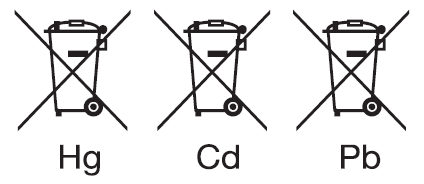
WARNING: DO NOT INGEST BATTERIES, CHEMICAL BURN HAZARD [the remote supplied with] This product contains a coin/button cell battery. If the coin/button cell battery is swallowed, it can cause severe international burns in just 2 hours and can lead to death. Keep new and used batteries away from children. If you think batteries might have been swallowed or placed inside any part of body, seek immediate medical attention.
For All Products Except Those with Wireless Operation
HARMAN International hereby declares that this equipment is in compliance with EMC 2014/30/EU Directive, LVD 2014/35/EU Directive. The declaration of conformity may be consulted in the support section of our Web Site, accessible from www.jbl.com.
For All Products with Wireless Operation
HARMAN International hereby declares that this equipment is in compliance with the essential requirements and other relevant provisions of Directive 2014/53/EU. The declaration of conformity may be consulted in the support section of our Web Site, accessible from www.jbl.com.
EPILEPSY WARNING
A few people may experience epileptic seizures when viewing flashing lights.
Precautions
Stand Mounting Safety Precautions Always follow instruction and precaution advice from speaker stand manufacturer.
This speaker contains a 36 mm receptacle cup to allow mounting on tripod stands or on a pole over subwoofers. When using stands or poles, be sure to observe the following precautions:
- Check the stand or pole specification to be certain the device is designed to support the weight of the speaker. Observe all safety precautions specified by the manufacturer.
- Always verify that the stand (or subwoofer/pole) is placed on a flat, level and stable surface and be sure to fully extend the legs of tripod type stands. Position the stand so that the legs do not present a trip hazard.
- Use this floor stand only on a flat, solid surface. Once the support (extended leg) has been placed and adjusted, carefully tighten the screws and use the safety pin. After placing the speaker on the stand, check for stability: When tilting each direction to 10 degrees (for the surface), the speaker should not turn off. If necessary, reduce the height of the speakers and extend the base of the stand.
- Route cables so that performers, production crew, and audience will not trip and topple the speakers over.
- Inspect the stand (or pole and associated hardware) before each use and do not use equipment with worn, damaged or missing parts.
- Do not attempt to place more than one PartyBox series speaker on a stand or pole.
- Always be cautious in windy, outdoor conditions. It may be necessary to place additional weight (i.e. sandbags) on the base of the stand to improve stability. Avoid attaching banners or similar items to any part of a speaker system. Such attachments could act as a sail and topple the system.
- Unless you are confident that you can handle the weight of the speaker, ask another person to help you get it onto the tripod stand or pole.
INTRODUCTION
Congratulations on your purchase! This manual includes information about PARTYBOX 310 speakers. We encourage you to take a few minutes to read this manual, which describes the product and includes step-by-step instructions to help you to set up and get started. Read and understand all the safety instructions before using your product. If you have any questions about these products, their installation or their operation, please contact your retailer or customer service, or visit us at www.jbl.com.
WHAT’S IN THE BOX
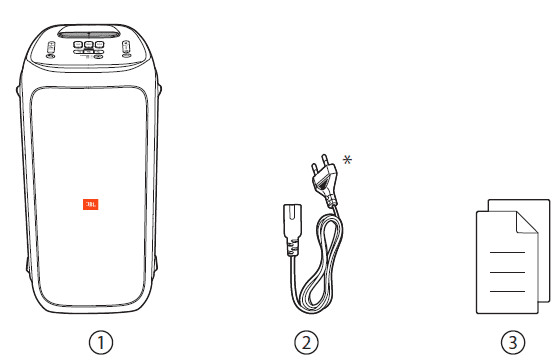
- Main unit
- Power cord*
- Quick Start Guide, Safety Sheet, Warranty Card
*Power cord quantity and plug type vary by regions.
PRODUCT OVERVIEW
Top Panel

- Telescopic handle
- – ECHO +
- Adjust the echo level.

- Press to enter Bluetooth pairing mode.
- Press and hold for more than 10 seconds to forget all paired devices.
- Battery level indicator

- Turn the power on or off.

- Press to switch between different light patterns.
- Hold for more than 2 seconds to turn strobe light on or off.

- Select an input source: BLUETOOTH, USB, or AUX.
- Mobile device dock
- LED ring

- Select a special sound effect such as horn, clapping, scratch.

- Enhances the bass level: level 1, level 2, or off.

- Play, pause or resume.

- Adjust main volume.
- – BASS +
- Adjust the bass level.
- – TREBLE +
- Adjust the treble level.
Caution: Do not look directly at the light-emitting parts when the speaker lights are turned on.
LED behavior
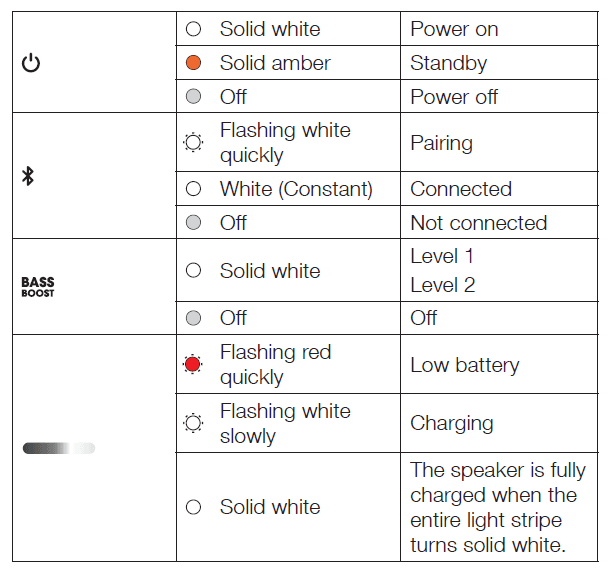
Back Panel
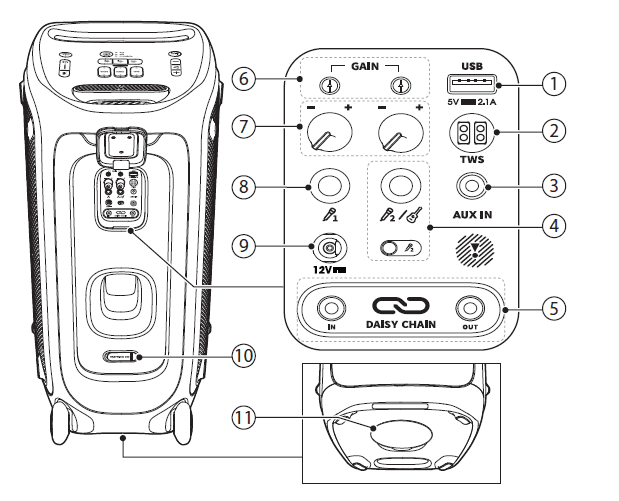
- USB
- Connect to a USB storage device.
- Charge your mobile device.
- TWS
- Press to enter True Wireless Stereo (TWS) pairing mode.
- AUX IN
- Connect to an external audio device through a 3.5 mm audio cable (not supplied).

- Connect to a microphone or guitar.
 IN/OUT
IN/OUT- Daisy-chain multiple PARTYBOX speakers through 3.5 mm audio cables (not supplied).
- GAIN controls
- Adjust gain of the corresponding microphone or guitar input.
- Microphone/guitar volume
- Adjust volume of the corresponding microphone/guitar (if connected).

- Connect to a microphone.

- Connect to 12V DC power supply.
- AC
- Connect to AC power supply.
- Pole-mounting your PARTYBOX
PLACEMENT
Caution: Do not sit or lean on the speaker or push it sideways to avoid tip-over and possible damages.
Place the speaker on a flat, stable surface and ensure that the rubber feet side is down.
POWER ON
Cautions
- Use the provided power cords only.
- You can use either AC/DC power or the built-in battery as power supply to the speaker.
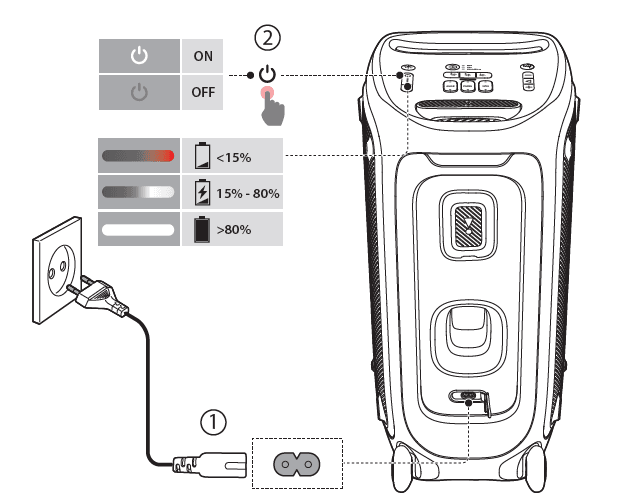
- Connect AC power.
- To use the built-in battery, disconnect AC or DC power after charging the speaker.
- Press to
 power on.
power on.- At step 1, you can also connect DC power using a cigarette lighter cable (sold separately): 46-ADT500-XX1 (US); 46- ADT502-XX1 (Non-US).
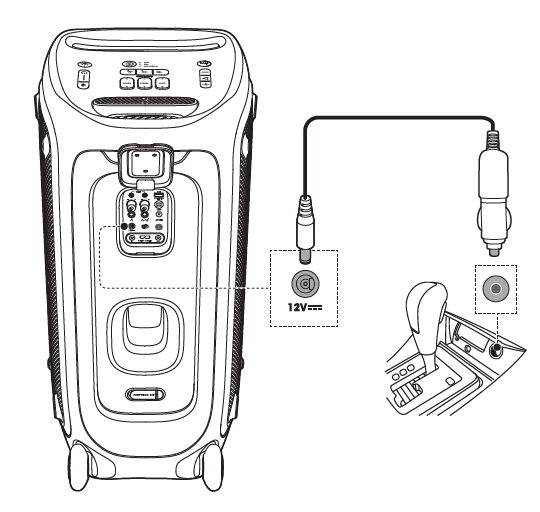
Tips
- Fully charge the speaker before first-time use to prolong the lifespan of the built-in battery.
- You can check the battery level by pressing any button on the speaker.
- The speaker switches to standby mode automatically after 20 minutes of inactivity. You can press on the speaker to switch to normal operation.
USING YOUR PARTYBOX
Notes:
- Only one sound source can be played at a time. The priority order is USB -> BLUETOOTH -> AUX.
- Starting a source with higher priority will always interrupt a source with lower priority.
- To start a source with lower priority, stop the source with higher priority first.
Bluetooth Connection
You can use the speaker with your Bluetooth enabled smartphone or tablet.
- Switch to the BLUETOOTH source.
- Press
 on the speaker to enter Bluetooth pairing mode.
on the speaker to enter Bluetooth pairing mode. - Choose “JBL PARTYBOX 310” on your Bluetooth device to connect.
- Once successfully connected, you can stream audio from your Bluetooth device to this speaker.
Notes:
- This speaker can memorize a maximum of 8 paired devices. The ninth paired device will replace the first one.
- Enter “0000” if a PIN code is requested for connection to a Bluetooth device.
- Bluetooth performance can be affected by the distance between this product and your Bluetooth device and the environment of operation.
To terminate the Bluetooth-enabled device:
- Turn off this speaker, or
- Disable Bluetooth on your device.
To reconnect the Bluetooth enabled device:
- When you turn on this speaker next time, it tries to reconnect the last connected device automatically.
- If not, manually select “JBL PARTYBOX 310” on your Bluetooth device to connect.
6.2 USB Connection
- Plug a USB storage device that contains playable audio contents into the USB port of the speaker.
- Switch to the USB source.
- Audio playback will start automatically.
Tip:
- The speaker plays audio files on the USB storage device from the root folder to the last level of subfolders in alphabetical sequence. Up to 8 levels of subfolders are supported.
Supported audio formats
| Extension | Codec | Sample rate | Bitrate |
|
WAVE |
PCM | 8 / 11.025 / 12 / 16 / 22.05 / 24 / 32 / 44.1 / 48 | 384 / 529.2 / 576 / 768 / 1058.4 / 1152 / 1536 / 2116.8 / 2304 |
|
MP3 | MPEG1 layer2/3 | 32 / 44.1 / 48 | 32 / 40 / 48 / 56 / 64 / 80 / 96 / 112 / 128 / 160 / 192 / 224 / 256 / 320 |
| MPEG2 layer2/3 | 16 / 22.05 / 24 | 8 / 16 / 24 / 32 / 40 / 48 / 56 / 64 / 80 / 96 / 112 / 128 / 144 / 160 | |
| MPEG2.5 layer3 | 8 / 11.025 / 12 | 8 / 16 / 24 / 32 / 40 / 48 / 56 / 64 / 80 / 96 / 112 / 128 / 144 / 160 | |
|
WMA | 8 / 11.025 / 16 / 22.05 / 32 / 44.1 / 48 | 5 / 6 / 8 / 10 / 12 / 16 / 20 / 22 / 32 / 36 / 40 / 44 / 48 / 64 / 80 / 96 / 128 / 160 / 192 / 256 / 320 |
6.3 Music Control
- Press
 once to pause or resume playback.
once to pause or resume playback. - Press
 twice to skip to the next track.
twice to skip to the next track. - Press
 three times to skip to the previous track.
three times to skip to the previous track. - Press +/- to increase or decrease main volume.
- Hold the + and – buttons simultaneously to mute or unmute sound output.
- Press BASS BOOST to enhance the bass level: level 1, level 2, or off.
Note: The skip operation is unavailable in AUX mode.
AUX Connection
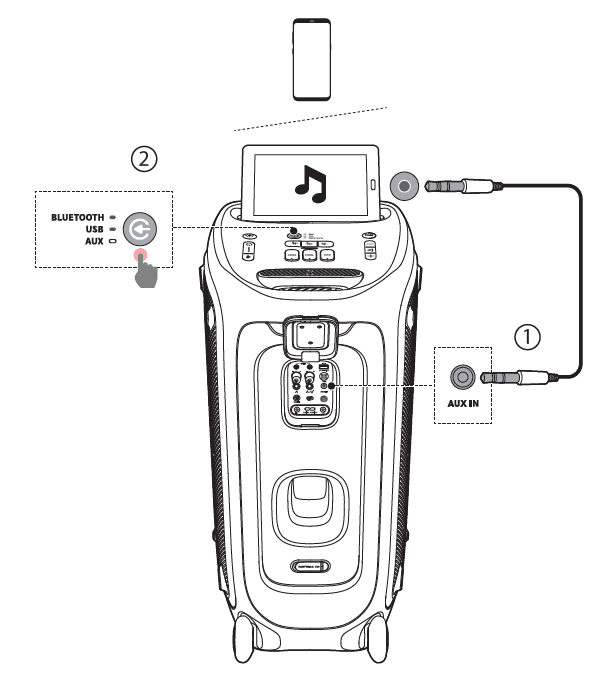
- Connect an external audio device to the speaker through a 3.5 mm audio cable (not supplied).
- Switch to the AUX source.
- Start audio playback on the external device.
Mixing Sound with a Microphone and / or Guitar
By using a microphone or electric guitar (not supplied), you can mix sound with an audio source.
Notes:
- Always set the guitar or microphone volume to the minimum level before guitar or microphone connection / disconnection.
- Always disconnect the guitar or microphone when you are not using them.
Connecting a Microphone
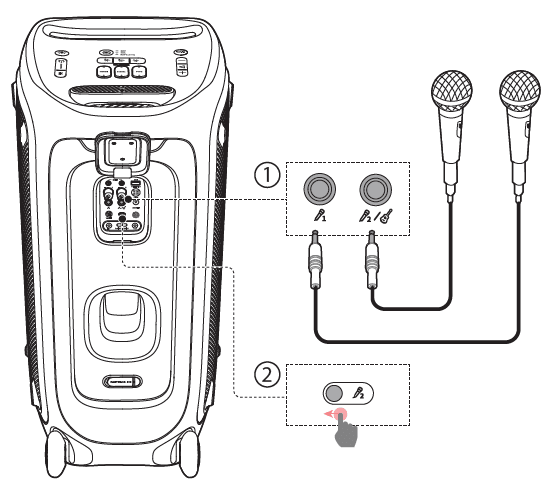
- Connect a microphone to the
 or
or socket.
socket. - When connecting a microphone to the
 socket, switch the slider to show
socket, switch the slider to show .
.
Connecting a Guitar
- Connect a guitar to the
 socket.
socket. - Switch the slider to show
 .
.
Mixing Sound
Sing through the microphone or play guitar.
- To adjust the volume of the audio source, press / .
- To adjust the volume of the microphone or guitar, rotate the MIC or GUITAR volume knob.
- To adjust the gain of the wired microphone or guitar, rotate the GAIN control beside the MICROPHONE or GUITAR socket respectively.
- To adjust the echo, treble and bass level of the microphone (either wireless or wired), rotate the ECHO, TREBLE and BASS knob respectively.
Charging Your Mobile Device
 CARRYING YOUR PARTYBOX
CARRYING YOUR PARTYBOX
Cautions:
- Before carrying the speaker, ensure that all the cords are disconnected.
- To avoid personal injury and/or property damage, hold the product firmly while carrying.
The telescopic handle design allows you to move the speaker around easily.
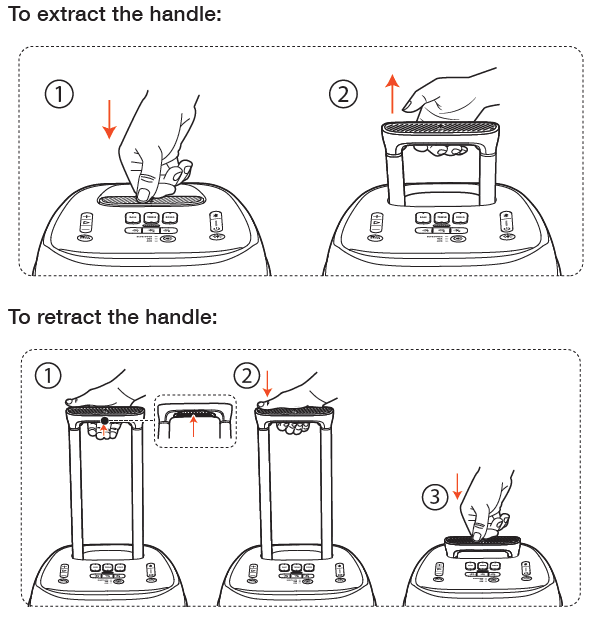
Caution for carrying the speaker:
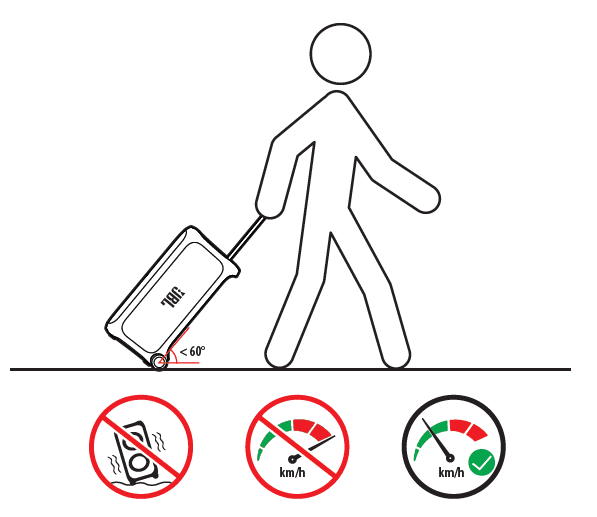
To avoid tip-over, do not drag the speaker on uneven surfaces or slopes where stability is doubtful. Stop or slow down when you feel any wiggle in the wheels.
POLE-MOUNTING YOUR PARTYBOX
Cautions:
- Installation must be done by qualified persons using safe rigging standards.
- The installer is responsible for proper selection and use of mounting hardware, to properly and safely pole-mount the speakers.
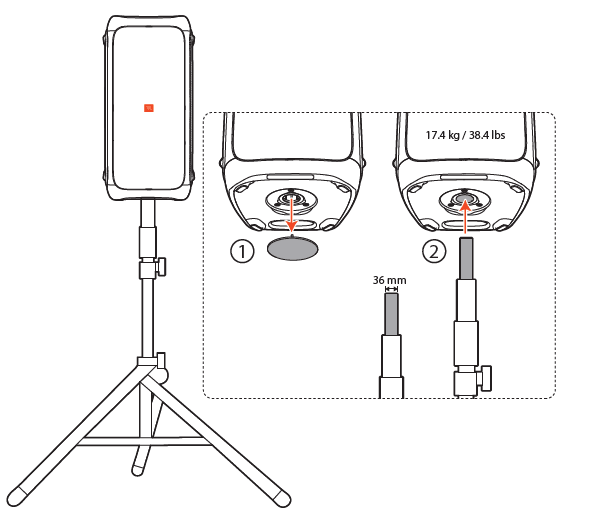
ADVANCED USAGE
JBL PARTYBOX App
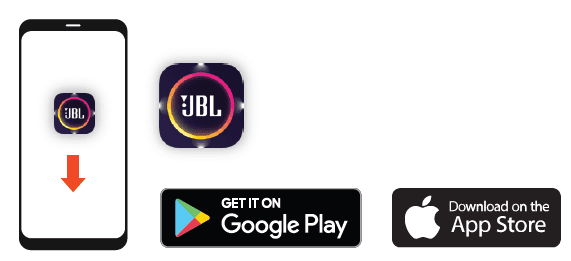
Download and install the JBL PARTYBOX App to get more from the product.
Light Effect
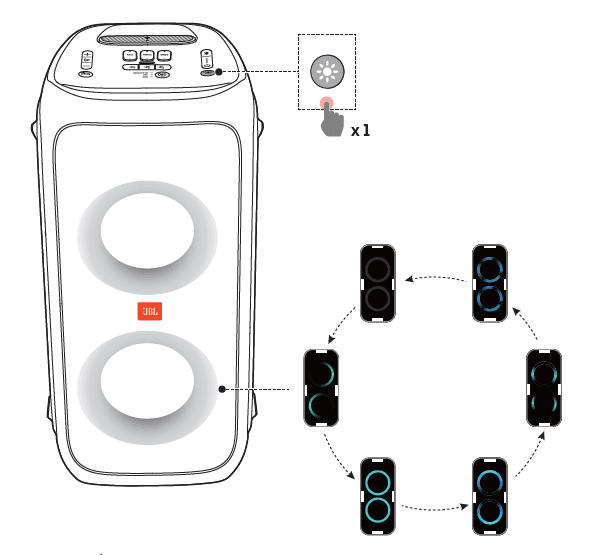
- Press
 to select your preferred light effect: rock, neon, club, or off.
to select your preferred light effect: rock, neon, club, or off. - Hold
 for more than 2 seconds to turn strobe light on or off.
for more than 2 seconds to turn strobe light on or off.
Sound Effect
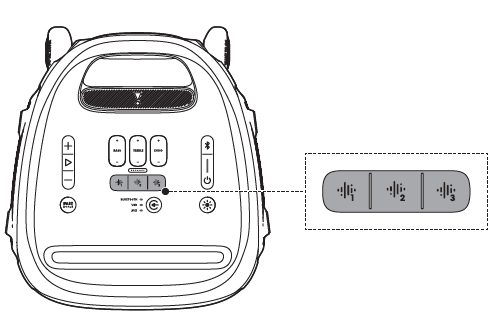
Press![]() to select a special sound effect such as horn, Press clapping, scratch.
to select a special sound effect such as horn, Press clapping, scratch.
TWS Mode
You can connect two PARTYBOX speakers to each other via TWS mode.
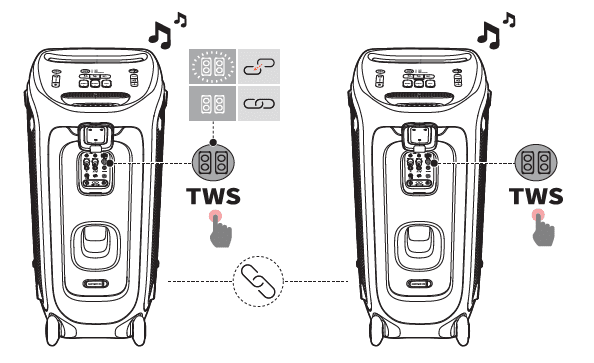
Press TWS on both speakers.
To exit TWS mode:
Power off or press TWS on either speaker.
Tip:
- By default, the speaker connected to your Bluetooth device acts as the primary speaker (left channel), while the other one acts as the secondary speaker (right channel).
Daisy Chain

Factory reset
To restore the factory settings, hold + and![]() for more than 10 seconds.
for more than 10 seconds.
IPX4
Cautions
- Always keep the charging port dry before connecting AC power.
- To ensure splash resistance, always keep the protective covers closed securely.
The speaker is IPX4 splash resistant.
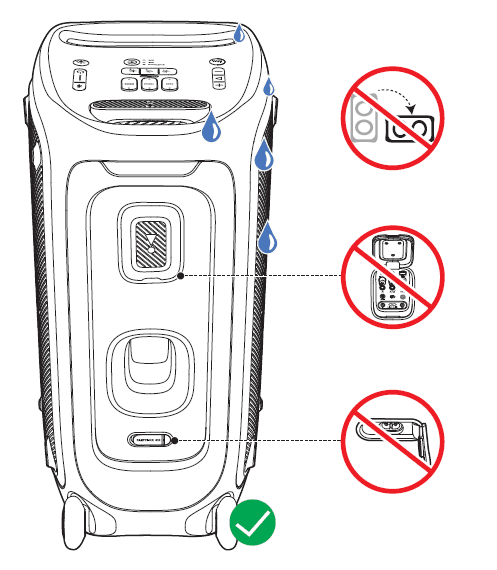
SPECIFICATIONS
| AC power input: | 100 – 240 V ~ 50/60 Hz |
| DC power input: | 12 V 4 A |
| Built-in battery: | 72 Wh |
| Power consumption: | 80 W |
| Standby power consumption: | < 2 W with Bluetooth connection; < 0.5W without Bluetooth connection |
| USB output: | 5 V 2.1 A (Max.) |
| Speaker drivers: | 2 x 6.5 inch (176 mm) woofers + 2 x 2.5 inch (65 mm) tweeters |
| Total output power: | 240 W RMS (AC powered) 140 W RMS (battery powered) 140 W RMS (car powered) |
| Signal-to-noise (S/N) ratio: | > 80 dBA |
| Frequency response: | 45 Hz – 20 kHz (-6 dB) |
| Battery charge time: | < 3.5 hrs |
| *Battery play time: | < 18 hrs |
| Bluetooth version: | 5.1 |
| Bluetooth profile: | A2DP V1.3, AVRCP V1.6 |
| Bluetooth transmitter frequency range: | 2.402 – 2480 MHz |
| Bluetooth maximum transmitter power: | 15 dBm (EIRP) |
| Bluetooth transmitter modulation: | GFSK, π/4 DQPSK, 8DPSK |
| Bluetooth range: | Approx. 10 m (33 ft) |
| USB format: | FAT16, FAT32 |
| USB file format: | .mp3, .wma, .wav |
| Input sensitivity: | Aux in: 250 mVrms (3.5 mm connector) Mic in: 20 mVrms; Guitar in: 100 mVrms Digital Input: Bluetooth/USB -12 dBFS |
| Product dimension (W x H x D): | 325.6 x 687.7 x 367.8 mm/ 12.8 x 27 x 14.5’’ |
| Packaging dimension (W x H x D): | 792 x 430 x 388 mm / 31.18 x 16.93 x 15.28’’ |
| Net weight: | 17.4 kg / 38.4 lbs |
| Gross weight: | 19.1 kg / 42.11 lbs |
*8 hrs battery playtime is only a reference and may vary depending on music content and battery aging after numerous charging and discharging cycles. It’s achievable with a predefined music source, light show switched off, volume level at 18 and Bluetooth streaming source.
TROUBLESHOOTING
Caution:
- Never try to repair the product by yourself. If you have any problems while using this product, check the following points before you request service.
System
The speaker will not turn on.
- Ensure that the speaker battery is not drained. If not, use the AC power instead.
No response from some buttons
- The product may be in demo mode. In demo mode, all the input sources and buttons except+ /- /
 /
/ /
/  are disabled. Hold
are disabled. Hold and
and simultaneously for more than 5 seconds to exit.
simultaneously for more than 5 seconds to exit.
Sound
No sound from the speaker.
- Ensure that the speaker is powered on.
- Adjust volume.
- Ensure that a sound source is active and not muted.
Bluetooth
A device cannot connect with the speaker.
- Ensure that the Bluetooth function of the device is enabled.
- The speaker is already connected with another Bluetooth device. Hold
 on the speaker for more than 20 seconds to disconnect and pair with a new device.
on the speaker for more than 20 seconds to disconnect and pair with a new device.
Poor audio quality from a connected Bluetooth device
- The Bluetooth reception is poor. Move the device closer to the speaker, or remove any obstacle between the device and speaker.
COMPLIANCE
The product is in compliance with the European Union energy legislation.
- Bluetooth connection mode: The product is intended to be used for streaming music via Bluetooth connection. A consumer can stream Bluetooth audio to the speaker. When the product is connected through Bluetooth, the Bluetooth connection must remain active at all times to ensure proper operation. The product will enter sleep mode (networked standby) after 20 minutes without operation. The power consumption in sleep mode is less than 2.0 Watts, after which it can be re-activated via Bluetooth connection.
- Bluetooth disconnection mode: The product will enter standby mode after 20 minutes without operation. The power consumption in standby mode is less than 0.5 Watts.
TRADEMARK

The Bluetooth® word mark and logos are registered trademarks owned by Bluetooth SIG, Inc. and any use of such marks by HARMAN International Industries, Incorporated is under license. Other trademarks and trade names are those of their respective owners.
For more manuals about JBL, visit ManualsLibraryy
JBL Partybox 310 Portable Party Speaker-FAQs
How can I tell if my JBL PartyBox 310 is fully charged?
The JBL PartyBox 310 is fully charged when the light strip on the speaker turns solid white.
How do I adjust the bass on my JBL PartyBox 310?
You can adjust the bass by pressing the Bass Boost button on the top control panel. It has three levels: Off, Level 1, and Level 2. Press the button multiple times to switch between these levels.
Does the JBL PartyBox 310 have Party Mode?
Yes, you can enable Party Mode by using the JBL PartyBox app if you have two of the same PartyBox models. You can also switch between Stereo and Party Mode in the app.
Can I use the JBL PartyBox 310 while it’s charging?
Yes, you can listen to music through a cabled connection while charging the JBL PartyBox 310.
How do I check the battery level on my JBL PartyBox 310?
After turning on the speaker, the battery level is displayed briefly. You can check it at any time by pressing any button on the speaker.
Does the JBL PartyBox 310 have bass boost?
Yes, the JBL PartyBox 310 includes a Bass Boost feature with adjustable levels to enhance your listening experience.
How do I adjust the EQ settings on my JBL PartyBox 310?
You can adjust the EQ settings through the JBL ONE app. Customize the bass, mid, and treble frequencies to match your sound preference.
Is the JBL PartyBox 310 waterproof?
The JBL PartyBox 310 has an IPX4 splashproof rating, meaning it can handle light splashes, so you can enjoy music outdoors.
How many watts is the JBL PartyBox 310?
The JBL PartyBox 310 delivers 240 watts of powerful sound output.

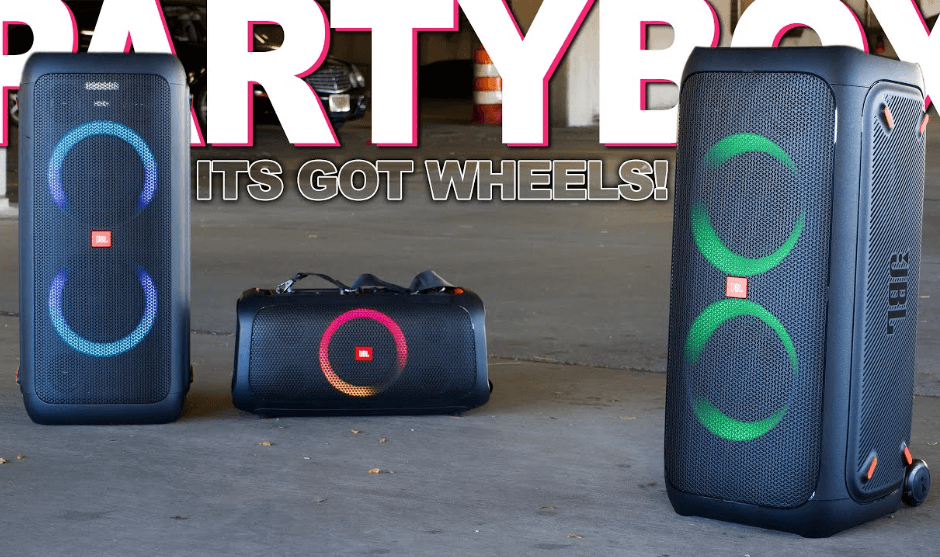
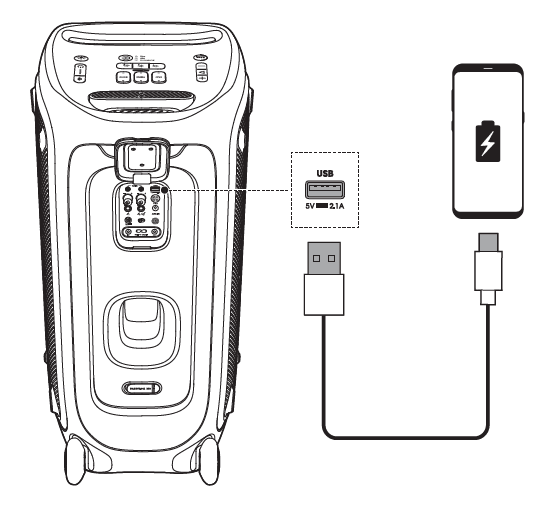 CARRYING YOUR PARTYBOX
CARRYING YOUR PARTYBOX